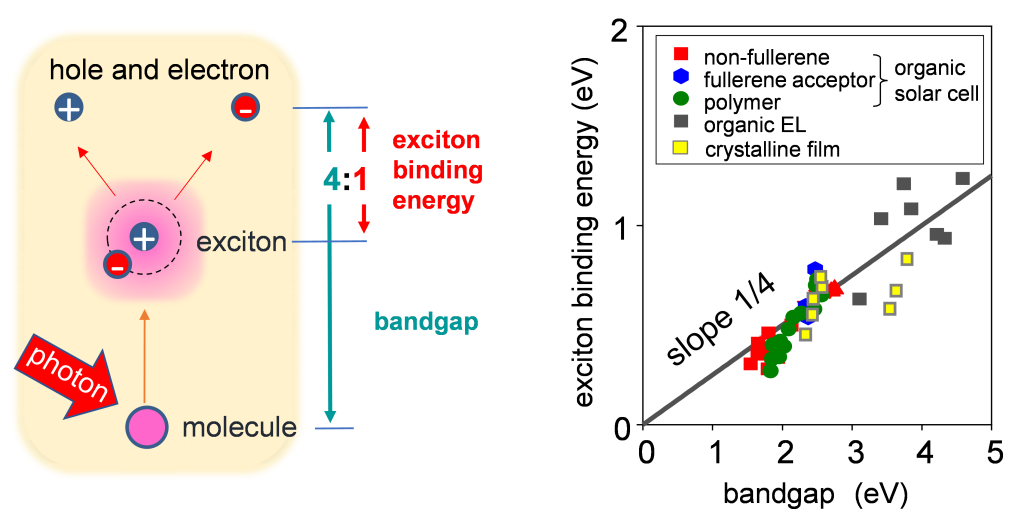Precise measurement of exciton binding energies in organic semiconductors reveals unexpected correlations and insights for organic optoelectronic devices
Organic semiconductors are materials that find applications in various electronic devices. Exciton binding energy is an important attribute that influences the behavior of these materials. Now, researchers have employed advanced spectroscopic techniques to accurately determine these energies for various organic semiconductor materials, with a high precision of 0.1 electron volts. Their study reveals unexpected correlations that are poised to shape the future of organic optoelectronics, influence design principles, and find potential applications in bio-related materials.

Image title: Relationship between exciton binding energy and transport bandgap.
Image caption: The solid line indicates the prediction based on the hydrogen atom model.
Image credit: Hiroyuki Yoshida from Chiba University, Japan
Image license: CC BY-NC-ND 4.0
Usage restrictions: You are free to share (copy and redistribute) this image in any medium or format, but credit must be given to the creator. Only non-commercial uses are permitted. Derivative works may be created for non-commercial purposes, but sharing is prohibited.
Organic semiconductors are a class of materials that find applications in various electronic devices owing to their unique properties. One attribute that influences the optoelectronic property of these organic semiconductors is their “exciton binding energy,” which is the energy needed to divide an exciton into its negative and positive constituents. Since high binding energies can have a significant impact on the functioning of optoelectronic devices, low binding energies are desirable. This can help in reducing energy losses in devices like organic solar cells. While several methods for designing organic materials with low binding energies have been investigated, accurately measuring these energies remains a challenge, primarily due to the lack of suitable energy measurement techniques.
Advancing research in this domain, a team of researchers led by Professor Hiroyuki Yoshida from the Graduate School of Engineering at Chiba University, Japan, have now shed light on the exciton binding energies of organic semiconductors. Their study was recently published online in The Journal of Physical Chemistry Letters on 11 December 2023. Ms. Ai Sugie from the Graduate School of Engineering at Chiba University, Dr. Kyohei Nakano and Dr. Keisuke Tajima from the Center for Emergent Matter Science at RIKEN, and Prof. Itaru Osaka from the Department of Applied Chemistry at Hiroshima University were involved with Prof. Yoshida in undertaking this study. Talking to us about their study, Prof. Yoshida says, “In this study, a previously unpredicted nature of exciton binding energies in organic semiconductors was revealed. Given the fundamental nature of our research, we expect long-term and persistent effects, both visible and invisible, on real-life applications.”
The team first experimentally measured the exciton binding energies for 42 organic semiconductors including 32 solar cell materials, seven organic light-emitting diode materials, and three crystalline compounds of pentacene. To compute the exciton binding energies, the researchers calculated the energy difference between the bound exciton and its “free carrier” state. While the former is given by the “optical gap,” linked to light absorption and emission, the latter is given by the “transport gap,” which denotes the energy needed to move an electron from the highest bound energy level to the lowest free energy level.
Experimental determination of the optical gap involved photoluminescence and photoabsorption experiments. Meanwhile, the transport gap was computed through ultraviolet photoelectron spectroscopy and low-energy inverse photoelectron spectroscopy, a technique pioneered by the research group. The use of this framework enabled the research team to determine exciton binding energies with a high precision of 0.1 electron volts (eV). The researchers believe that this precision level can help discuss the exciton nature of organic semiconductors with much higher confidence than previous studies.
Moreover, the researchers observed an unexpected aspect of the nature of exciton binding energies. They found that the exciton binding energy is one-quarter of the transport bandgap, irrespective of the materials involved.
The outcomes of this study are set to shape the fundamental principles pertaining to organic optoelectronics and also have potential real-life applications. For instance, the design principles regulating organic optoelectronic devices are expected to change favorably. Moreover, given the potential of these findings to influence concepts within the field, the researchers believe that these findings are also likely to be included in future textbooks.
Sharing his closing thoughts, Prof. Yoshida says, “Our study contributes to advancing the current understanding of the mechanism of excitons in organic semiconductors. Moreover, these concepts are not only limited to organic semiconductors but can also be applied to a wide range of molecular-based materials, such as bio-related materials.”
Here’s hoping that this work paves the way for more exciting developments in the field of organic semiconductors for next-generation electronics!
About Professor Hiroyuki Yoshida
Hiroyuki Yoshida is a Professor at the Graduate School of Engineering and the Molecular Chirality Research Center at Chiba University, Japan. Prof. Yoshida earned his Ph.D. from the University of Tokyo in 1995. His research focuses on functional solid-state chemistry, and he has over 90 publications and 3,100 citations to his credit. He is also the recipient of several distinguished awards, including the 8th Outstanding Achievement Award at the Japan OLED Forum in 2015, the 12th Best Paper Award from The Japan Society of Applied Physics, Molecular Electronics and Bioelectronics in 2014, and the Best Oral Presentation Award at the Grand Renewable Energy 2014 International Conference.
Funding:
This work was supported by the MIRAI Program (Grant No. JPMJMI20E2) of the Japan Science and Technology Agency (JST), KAKENHI (Grant No. 21H05384) of Japan Society for the Promotion of Science (JSPS), and the Futaba Research Grant Program of the Futaba Foundation.
Reference:
Title of original paper: Dependence of Exciton Binding Energy on Bandgap of Organic Semiconductors
Authors: Ai Sugie1, Kyohei Nakano2, Keisuke Tajima2, Itaru Osaka3, and Hiroyuki Yoshida1,4
Affiliations:
1Graduate School of Engineering, Chiba University
2RIKEN Center for Emergent Matter Science (CEMS)
3Department of Applied Chemistry, Hiroshima University
4Molecular Chirality Research Center, Chiba University
Journal: The Journal of Physical Chemistry Letters
DOI: 10.1021/acs.jpclett.3c02863
Contact: Hiroyuki Yoshida, Professor, Graduate School of Engineering, Chiba University
Email: hyoshida@chiba-u.jp
Public Relations Office, Chiba University
Address: 1-33 Yayoi, Inage, Chiba 263-8522 JAPAN
Email: koho-press@chiba-u.jp
Tel: +81-43-290-2018




